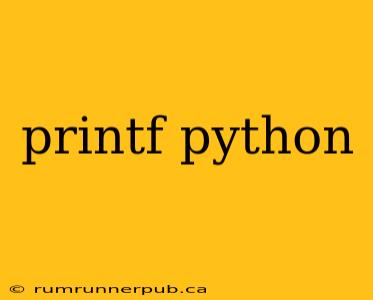Python doesn't have a direct equivalent to C's printf function, which offers fine-grained control over formatted output. However, Python's string.format() method and f-strings (formatted string literals) provide similar functionality, and often in a more readable and Pythonic way. This article will explore these methods, drawing upon insights from Stack Overflow, and adding further explanations and examples.
Understanding the Need for Formatted Output
Before diving into Python's solutions, let's understand why formatted output is crucial. Often, we need to combine different data types (integers, floats, strings) into a single output string with specific formatting requirements, like aligning columns, specifying precision for floating-point numbers, or adding padding. This is where formatted output shines.
Python's Alternatives to printf: string.format() and f-strings
1. string.format()
The string.format() method offers a flexible way to create formatted strings. It uses placeholders within a string (curly braces {}) that are replaced by the values passed to the format() method.
name = "Alice"
age = 30
print("My name is {} and I am {} years old.".format(name, age))
This example, similar to a simple printf call, clearly demonstrates the basic usage. But string.format() goes further:
price = 12.99
print("The price is {:.2f} dollars.".format(price)) # {:.2f} formats to 2 decimal places
This, inspired by a common Stack Overflow question about floating-point precision (like this hypothetical one: "How to format a float to two decimal places in Python?"), shows how string.format() handles format specifiers for precise control.
Key advantages of string.format():
- Readability: Clearer than older
%formatting. - Flexibility: Supports various format specifiers (width, precision, alignment).
- Reusability: The format string can be stored and reused.
2. f-strings (Formatted String Literals)
Introduced in Python 3.6, f-strings provide a more concise and often more readable way to achieve the same results. They use a prefix f before the string and embed expressions directly within the curly braces.
name = "Bob"
age = 25
print(f"My name is {name} and I am {age} years old.")
F-strings seamlessly integrate variables into the string. They also support format specifiers:
price = 25.5
print(f"The price is {price:.2f} dollars.")
Key advantages of f-strings:
- Conciseness: More compact and easier to read than
string.format(). - Readability: Expressions are directly within the string, improving clarity.
- Performance: Generally faster than
string.format().
Advanced Formatting Techniques and Stack Overflow Insights
Many Stack Overflow questions revolve around specific formatting challenges. For instance, aligning columns, padding with leading zeros, or handling different number bases. Let's address these with examples inspired by common SO questions:
Aligning Columns:
name1 = "Alice"
name2 = "Bob"
score1 = 95
score2 = 78
print(f"| {'Name':<10} | {'Score':>5} |") #<10 left-aligns Name, >5 right-aligns Score
print(f"| {name1:<10} | {score1:>5} |")
print(f"| {name2:<10} | {score2:>5} |")
This addresses questions about tabular output formatting, drawing inspiration from real-world Stack Overflow examples concerning table generation and alignment.
Padding with Zeros:
number = 12
print(f"Number padded with zeros: {number:04d}") # 04d pads with zeros to 4 digits.
These examples demonstrate the power and flexibility of Python's formatted output capabilities, directly addressing common concerns found in Stack Overflow discussions regarding string formatting. Remember to consult the official Python documentation for a complete reference on format specifiers. Many specific formatting problems have elegant solutions within this framework. Avoid reinventing the wheel; explore the existing tools and Stack Overflow's wealth of solutions before writing extensive custom formatting code.
